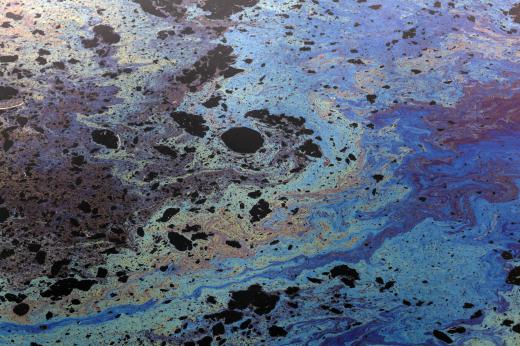What Is an Anionic Surfactant?
An anionic surfactant is a macromolecule, usually in the sulfonate or sulfate group of chemicals such as sodium laureth sulfate, that acts as an active surface agent to lower the surface tension of liquids. This allows them to bind to impurities and particles that are suspended in the liquid, which makes them effective cleaning agents in water. In small concentrations, they can also cause the foaming of compounds in water by creating large numbers of small bubbles of gas, and this makes them effective in cosmetics such as shampoo, toothpaste, and in fire-suppressing agents.
Basic soap used to clean the human body is also a type of surfactant or detergent made from natural fatty acids of plant or animal origin. The difference with an anionic surfactant is that it is largely a synthetic chemical, and it has been designed to act not only as a surfactant that binds to oils and particulates in water, but also as a denaturing chemical for proteins. Since anionic surfactants break down proteins attached to clothing in water, they are not recommended for ordinary soap use, as human skin is also a type of protein.

Chemical engineering has been perfecting anionic surfactant synthetic detergents since the late 1940s when they began to replace ordinary soap for washing machine use. The negative electrical charge of their ionic nature makes them bind to dissolved minerals in hard water. Ordinary soap will leave an insoluble, gray-colored film on materials that are washed in hard water. Early surfactant detergents were based on alkylate compounds, and the drawback to their use was that they are carried out to natural waterways in the waste water systems of cities where their foaming ability prevents breakdown by natural microorganisms. These compounds were made illegal by 1965 in most nations, and a switch to related alkylbenzene sulfonate (LAS) chemicals alleviated some of the issues with water pollution.

LAS surfactants now have a wide variety of uses. They are key to the emulsion polymerization of several plastics, such as polystyrene, are used in protecting agricultural seed from mold and fungi, and are included in a wide variety of emulsified paints. Industrial cleaning supplies are also dependent on LAS compounds, and about 50% of all LAS production goes toward household detergent products.
Nonionic surfactants are less harsh than their counterparts and have some similarities to ordinary soap, making them suitable for widespread use in hand dishwashing liquids and other household cleaners where contact with human skin is frequent. They are most effective at breaking up grease residue produced in cooking. This is because they are related to grease molecules, and are derived from fatty alcohols manufactured from ethylene, paraffin, and so on. The compounds have both petroleum-based and natural sources. About 5% of all of the petroleum production worldwide as of 2003 went to the manufacture of fatty alcohol nonionic surfactants, accounting for 212,000,000 metric tons of the compound produced globally.
Special types of anionic surfactant compounds known as biosurfactants are also used in oil spill remediation. They are derived from natural compounds and have oleophilic molecular ends for oil cleanup and hydrophilic ends for binding to water molecules. Like a typical anionic surfactant, they reduce surface tension in the water to break large oil droplets down into smaller ones that can then disperse and biodegrade naturally. Biosurfactants allow oil cleaning operations to channel polluted water directly to waste water treatment plants, or they break the oil slick down enough that natural bacteria in the water can then further degrade the dispersed oil droplets.
AS FEATURED ON:
AS FEATURED ON:












Discussion Comments
Thanks for this really good explanation! is there a test that allows you to identify which surfactant (either anionic or nonionic) is present?
Post your comments